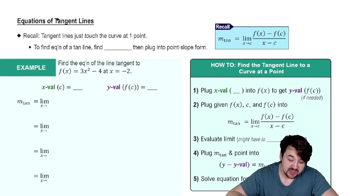Table of contents
- 0. Functions7h 52m
- Introduction to Functions16m
- Piecewise Functions10m
- Properties of Functions9m
- Common Functions1h 8m
- Transformations5m
- Combining Functions27m
- Exponent rules32m
- Exponential Functions28m
- Logarithmic Functions24m
- Properties of Logarithms34m
- Exponential & Logarithmic Equations35m
- Introduction to Trigonometric Functions38m
- Graphs of Trigonometric Functions44m
- Trigonometric Identities47m
- Inverse Trigonometric Functions48m
- 1. Limits and Continuity2h 2m
- 2. Intro to Derivatives1h 33m
- 3. Techniques of Differentiation3h 18m
- 4. Applications of Derivatives2h 38m
- 5. Graphical Applications of Derivatives6h 2m
- 6. Derivatives of Inverse, Exponential, & Logarithmic Functions2h 37m
- 7. Antiderivatives & Indefinite Integrals1h 26m
- 8. Definite Integrals4h 44m
- 9. Graphical Applications of Integrals2h 27m
- 10. Physics Applications of Integrals 2h 22m
6. Derivatives of Inverse, Exponential, & Logarithmic Functions
Derivatives of Inverse Trigonometric Functions
Problem 3.10.9
Textbook Question
If f is a one-to-one function with f(3)=8 and f′(3)=7, find the equation of the line tangent to y=f^−1(x) at x=8.
 Verified step by step guidance
Verified step by step guidance1
First, understand that the problem involves finding the tangent line to the inverse function f^−1(x) at a specific point. We are given that f(3) = 8, which means that f^−1(8) = 3.
Recall that the derivative of the inverse function at a point x is given by the formula: (f^−1)'(x) = 1 / f'(f^−1(x)). This formula helps us find the slope of the tangent line to the inverse function.
Substitute the given values into the formula: Since f^−1(8) = 3 and f′(3) = 7, we have (f^−1)'(8) = 1 / 7. This is the slope of the tangent line at x = 8.
Now, use the point-slope form of the equation of a line, which is y - y₁ = m(x - x₁), where m is the slope and (x₁, y₁) is a point on the line. Here, the point is (8, 3) and the slope m is 1/7.
Substitute the values into the point-slope form: y - 3 = (1/7)(x - 8). This equation represents the tangent line to y = f^−1(x) at x = 8.
 Verified video answer for a similar problem:
Verified video answer for a similar problem:This video solution was recommended by our tutors as helpful for the problem above
Video duration:
4mPlay a video:
Was this helpful?
Key Concepts
Here are the essential concepts you must grasp in order to answer the question correctly.
Inverse Function
An inverse function reverses the effect of the original function. If f(x) takes an input x and produces an output y, then the inverse function f^−1(y) takes y back to x. For a function to have an inverse, it must be one-to-one, meaning each output is produced by exactly one input.
Recommended video:

Inverse Cosine
Derivative of Inverse Functions
The derivative of an inverse function can be found using the formula (f^−1)'(y) = 1 / f'(x), where y = f(x). This relationship is crucial for finding the slope of the tangent line to the inverse function at a given point, as it connects the rates of change of the original and inverse functions.
Recommended video:

Derivatives of Inverse Sine & Inverse Cosine
Tangent Line Equation
The equation of a tangent line at a point on a curve can be expressed as y - f(a) = f'(a)(x - a), where (a, f(a)) is the point of tangency. This equation uses the slope of the function at that point and the coordinates to describe the line that just touches the curve without crossing it.
Recommended video:

Equations of Tangent Lines

 7:26m
7:26mWatch next
Master Derivatives of Inverse Sine & Inverse Cosine with a bite sized video explanation from Callie
Start learning


